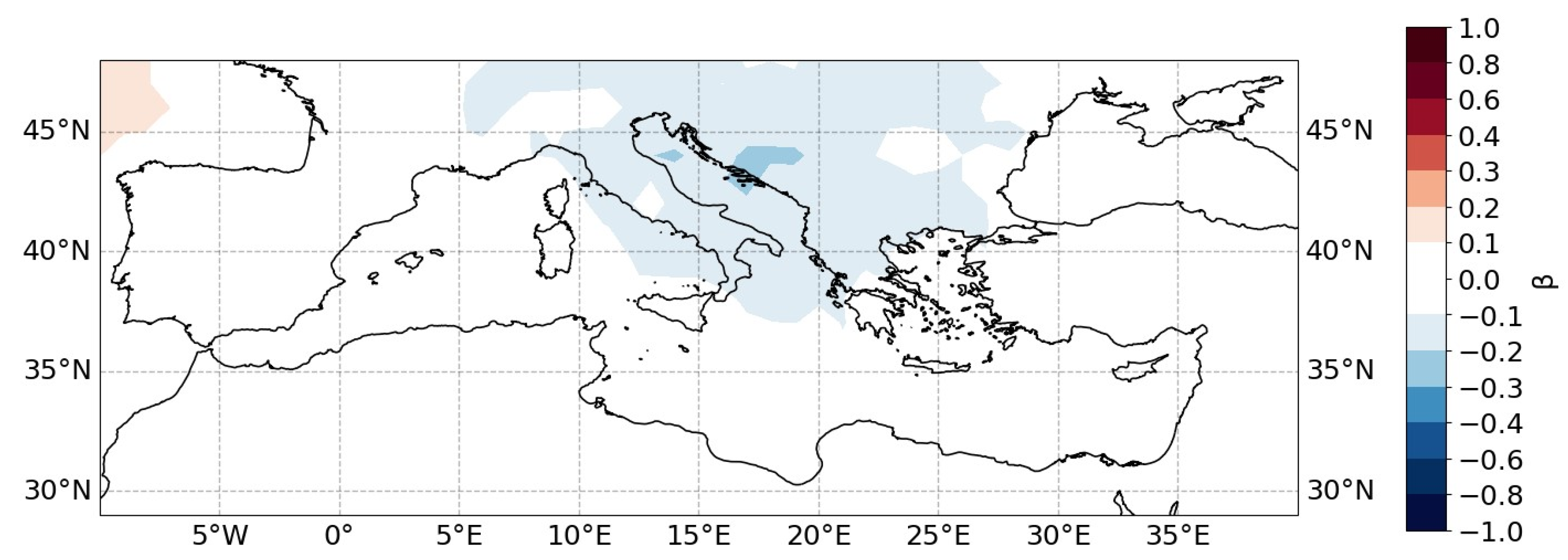Causal Drivers of Mediterranean Winter Climate Variability †
Abstract
:1. Introduction
2. Material and Methods
3. Results
4. Conclusions
Author Contributions
Funding
Institutional Review Board Statement
Informed Consent Statement
Data Availability Statement
Acknowledgments
Conflicts of Interest
References
- Hatzaki, M.; Flocas, H.A.; Giannakopoulos, C.; Maheras, P. The Impact of the Eastern Mediterranean Teleconnection Pattern on the Mediterranean Climate. J. Clim. 2009, 22, 977–992. [Google Scholar] [CrossRef]
- Lemus-Canovas, M. Changes in compound monthly precipitation and temperature extremes and their relationship with teleconnection patterns in the Mediterranean. J. Hydrol. 2022, 608, 127580. [Google Scholar] [CrossRef]
- Runge, J.; Nowack, P.; Kretschmer, M.; Flaxman, S.; Sejdinovic, D. Detecting and quantifying causal associations in large nonlinear time series datasets. Sci. Adv. 2019, 5, eaau4996. [Google Scholar] [CrossRef] [PubMed]
- Runge, J.; Donner, R.V.; Kurths, J. Optimal model-free prediction from multivariate time series. Phys. Rev. E 2015, 91, 052909. [Google Scholar] [CrossRef] [PubMed]
- Runge, J. Causal network reconstruction from time series: From theoretical assumptions to practical estimation. Chaos Interdiscip. J. Nonlinear Sci. 2018, 28, 075310. [Google Scholar] [CrossRef] [PubMed]
- McGraw, M.C.; Barnes, E.A. Memory Matters: A Case for Granger Causality in Climate Variability Studies. J. Clim. 2018, 31, 3289–3300. [Google Scholar] [CrossRef]
- Kretschmer, M.; Coumou, D.; Donges, J.F.; Runge, J. Using Causal Effect Networks to Analyze Different Arctic Drivers of Midlatitude Winter Circulation. J. Clim. 2016, 29, 4069–4081. [Google Scholar] [CrossRef]
- Di Capua, G.; Kretschmer, M.; Donner, R.V.; van den Hurk, B.; Vellore, R.; Krishnan, R.; Coumou, D. Tropical and mid-latitude teleconnections interacting with the Indian summer monsoon rainfall: A theory-guided causal effect network approach. Earth Syst. Dynam. 2020, 11, 17–34. [Google Scholar] [CrossRef]
- Di Capua, G.; Runge, J.; Donner, R.V.; van den Hurk, B.; Turner, A.G.; Vellore, R.; Krishnan, R.; Coumou, D. Dominant patterns of interaction between the tropics and mid-latitudes in boreal summer: Causal relationships and the role of timescales. Weather Clim. Dynam. 2020, 1, 519–539. [Google Scholar] [CrossRef]
- Hatzaki, M.; Flocas, H.A.; Asimakopoulos, D.N.; Maheras, P. The eastern Mediterranean teleconnection pattern: Identification and definition. Int. J. Climatol. 2007, 27, 727–737. [Google Scholar] [CrossRef]
- Hurrell, J.W.; Kushnir, Y.; Ottersen, G.; Visbeck, M. An Overview of the North Atlantic Oscillation. In The North Atlantic Oscillation: Climatic Significance and Environmental Impact; Wiley: Hoboken, NJ, USA, 2003; pp. 1–35. [Google Scholar] [CrossRef]
- Barnston, A.G.; Livezey, R.E. Classification, Seasonality and Persistence of Low-Frequency Atmospheric Circulation Patterns. Mon. Weather Rev. 1987, 115, 1083–1126. [Google Scholar] [CrossRef]
- Hersbach, H.; Bell, B.; Berrisford, P.; Hirahara, S.; Horányi, A.; Muñoz-Sabater, J.; Nicolas, J.; Peubey, C.; Radu, R.; Schepers, D.; et al. The ERA5 global reanalysis. Q. J. R. Meteorol. Soc. 2020, 146, 1999–2049. [Google Scholar] [CrossRef]


Disclaimer/Publisher’s Note: The statements, opinions and data contained in all publications are solely those of the individual author(s) and contributor(s) and not of MDPI and/or the editor(s). MDPI and/or the editor(s) disclaim responsibility for any injury to people or property resulting from any ideas, methods, instructions or products referred to in the content. |
© 2023 by the authors. Licensee MDPI, Basel, Switzerland. This article is an open access article distributed under the terms and conditions of the Creative Commons Attribution (CC BY) license (https://creativecommons.org/licenses/by/4.0/).
Share and Cite
Hatzaki, M.; Di Capua, G.; Chaniotis, J.; Patlakas, P.; Donner, R.V.; Flocas, H.A. Causal Drivers of Mediterranean Winter Climate Variability. Environ. Sci. Proc. 2023, 26, 155. https://doi.org/10.3390/environsciproc2023026155
Hatzaki M, Di Capua G, Chaniotis J, Patlakas P, Donner RV, Flocas HA. Causal Drivers of Mediterranean Winter Climate Variability. Environmental Sciences Proceedings. 2023; 26(1):155. https://doi.org/10.3390/environsciproc2023026155
Chicago/Turabian StyleHatzaki, Maria, Giorgia Di Capua, John Chaniotis, Platon Patlakas, Reik V. Donner, and Helena A. Flocas. 2023. "Causal Drivers of Mediterranean Winter Climate Variability" Environmental Sciences Proceedings 26, no. 1: 155. https://doi.org/10.3390/environsciproc2023026155
APA StyleHatzaki, M., Di Capua, G., Chaniotis, J., Patlakas, P., Donner, R. V., & Flocas, H. A. (2023). Causal Drivers of Mediterranean Winter Climate Variability. Environmental Sciences Proceedings, 26(1), 155. https://doi.org/10.3390/environsciproc2023026155







